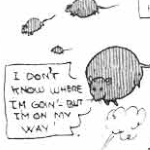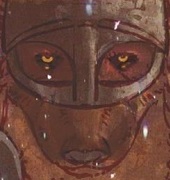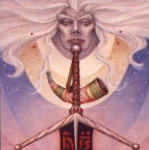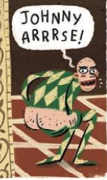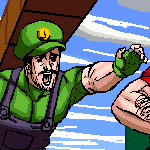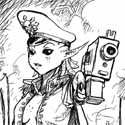|
Next chapter is what happens when a random bug hits, incidentally. Sometimes, through no fault of its own, an angel's mission becomes impossible to complete. They made no choice to Fall, they had no agency in their failure to obey properly. Something just went wrong somewhere. They disconnect from the Machine but don't Fall. That's an Exile, and they...well, they tend to be stuck in the middle. They usually don't want to Fall because they usually feel they did nothing wrong and just want to reconnect to the boss but, for some reason, can't. They can fully Fall and become demons, but it's kind of hard to choose to disobey when you don't receive orders any more, because God has literally forgotten you exist.
|
|
|
|

|
| # ? Apr 27, 2024 01:07 |
|
Mors Rattus posted:They can fully Fall and become demons, but it's kind of hard to choose to disobey when you don't receive orders any more, because God has literally forgotten you exist. The nDemon version of that guy's apocryphal story about falling between the floorboards in a corporate re-organization and getting paid to do nothing.
|
|
|
|
PurpleXVI posted:The nDemon version of that guy's apocryphal story about falling between the floorboards in a corporate re-organization and getting paid to do nothing. Given spatial-folding to store clerical infrastructure nested within human offices, that guy might have literally gotten stuck between the floors, too.
|
|
|
|
Flail Snail posted:Like how one fell because he had an intrusive thought about going outside, meanwhile this one cleaner lady is actively coming closer and closer to sabotaging the GM because she desires increased challenge? I think this is intentional - the God-Machine is, when you peel back even a little bit, a huge jury-rigged mess. Angels are janky, they regularly break away and become fully autonomous entities that represent the most direct possible threat to the Machine. The Machine doesn't even have a good sense of when an angel is going to fall, and it builds them. It's a computer-monster running on the weird occult holes in a badly designed reality, and the tools at its disposal are weird, occult, and inconsistent. And yet it runs the world. Somebody should do something about that.
|
|
|
|
The other thing is it's about orders. If your orders include "never leave this room," thinking about leaving can be choosing to disobey. The Gardener and Ms. Morgue have explicitly found ways to 'rebel' that don't directly disobey their orders. They're nearing a Fall but they haven't chosen to actually disobey yet.
|
|
|
|
PurpleXVI posted:The nDemon version of that guy's apocryphal story about falling between the floorboards in a corporate re-organization and getting paid to do nothing. What happens when an Angel finds Heaven?
|
|
|
|
That's just the recycling center.
|
|
|
|
Just use a bubble tea machine to seal up your cups of PissCoin. Easy.
|
|
|
|
So, this... exists: https://www.feastoflegends.com/ Wendy's made a 97 loving page tabletop RPG with full color illustrations, a sizeable adventure, and a map. From cursory examination, it looks surprisingly decent. Apparently they have physical copies at NYCC. Someone please, please do a writeup. I beg you.
|
|
|
|
PantsOptional posted:So, this... exists: https://www.feastoflegends.com/
|
|
|
|
Chernobyl Peace Prize posted:You can tell it's a real game because it's got DND stats except different names and 5 instead of 6. Some thought and effort was actually put into this. What the gently caress. This seems better than some RPG books that I've paid money for. This seems better than some RPG books that I've been paid money for.
|
|
|
|
PantsOptional posted:So, this... exists: https://www.feastoflegends.com/ Alright this is actually weirder to me than anything I've seen in this thread.
|
|
|
|
Someone in Wendy’s marketing department is both a huge nerd and very, very good at selling their ideas.
|
|
|
|
Chernobyl Peace Prize posted:You can tell it's a real game because it's got DND stats except different names and 5 instead of 6. Some thought and effort was actually put into this. What the gently caress. I'm genuinely interested in somebody literate in D&D 5e writing a rundown of this game up with an eye towards how much of this game is just reprinted 5e with minor tweaks, vs. using 5e as a base but actually coming up with some stuff. Aside from the +1 ice damage you suffer from all attacks for the day if you eat a hamburger that was once frozen. We can all agree that's novel design.
|
|
|
|
I've looked through it. It seems... surprisingly competent at least from a quick read. There are a few issues though: 1) All stats and HP are rolled, 4d4 (every time they mention this, they call it out as a reference to "4 for $4. Nailed it") and there is no point buy 2) Eating a meal gives a bonus that stacks, and if you eat a meal that aligns with your Order (class) you get Advantage on all attacks for the day. This is crazy strong 3) Given how incredibly important meals are, there are no listed costs or ways to acquire said meals I do like FEAST MODE, their equivalent to critical hits. Not only do you do crit damage on a 20, but you also get advantage to your next attack. It's a neat little thing to help keep a lucky streak rolling
|
|
|
|
I Am Just a Box posted:I'm genuinely interested in somebody literate in D&D 5e writing a rundown of this game up with an eye towards how much of this game is just reprinted 5e with minor tweaks, vs. using 5e as a base but actually coming up with some stuff. I have a good eye for D&D 5e and... it's really not just a reprint. It's obviously inspired by D&D 5e, but it very much does its own thing outside of that. This game has more novelty and design than most heartbreakers
|
|
|
|
Mors Rattus posted:Someone in Wendy’s marketing department is both a huge nerd and very, very good at selling their ideas. I present independent verification of this claim.
|
|
|
|
Night Horrors: Enemy Action Part 10: Bent But Unfallen  Mapmaker, mapmaker, make me a map Carta was ordered to map the city, long ago. The first city. She was well on her way to doing so when, out of nowhere, language and humanity and everything splintered and broke. She failed the mission, and for her failure she was boxed up. She has been boxed up and released more times than she can count, but she never actually received an update to her original imperatives. In fact, she can no longer sense the Machine at all. "Map the city" is all she has. Unfortunately, the sheer number of human cities in existence and their constant state of growth and renewal makes this mission literally impossible. She has tentatively put her skills to other, less frustrating uses, but Carta refuses to deviate too far from her mission parameters for fear of losing her sense of self. A secondary program in her core, however, has awakened, and it makes her lash out at the mortals that so frustrate her. Carta can remember only bits and pieces of the first city. She's unsure if her memory is malfunctioning or if the God-Machine erased parts of it after her original failure. Both are possible. She recalls a great tower of red stone and shining bronze, a miracle of engineering by any standard of the period. She remembers unity. Humans spoke with one tongue, and so they were as one. Carta understands that language is the key to everything. Everything. If you can speak of a thing, capture the idea in words, then it can be made. Modern human languages, compared to that original, are pitiful things. They are fractured, able to encompass a mere three dimensions and stuck in linear time. She remembers that the original language was so much more. It could paint with starlight and travel all space in a single syllable. This, she believes, is why the Machine broke it. She has buried what little of the original language that she can still recall as deep in her memory banks as possible, to keep it hidden. Breaking the ur-language, she believes, destroyed the nascent threat and potential that humans had, but it also made her mission impossible to complete. The Machine gave her the eyes to see, the hands to draw with, but it gave her no means to travel physical space fast enough to keep up with humanity's drive to tear down, expand, build and rebuild. Even worse, they've made so many cities now that she doesn't even know which city is the city that has to be mapped. After her original failure, Carta was sent out by the Machine to make more maps. For millenia, she was endlessly released and boxed in an endless loop of constant failure. Some stand out more than others. She was sent to Ur and it fell to drought. She was sent to Koumbi Saleh and the trade routes went obsolete and it was abandoned. She was sent to Troy and it was razed. She was sent to Constantinople and found it trapped in a constant cycle of destruction and rebuilding. She was sent to London and it burned down. She never got her operating parameters updated, so she kept trying to map each, and she always failed and was always recalled. Her last official mission was in Kowloon Walled City, and it was the first time in millenia that she'd felt hope. At that point the thing was packed with blocks and had little room left to expand into. She worked frantically...and in 1993, it was demolished before she could finish. Fed up, she reached out to the Machine in an effort to sever her connection and finally rebel - and found that the connection was gone. Either the Machine sensed her intent and blocked her preemptively, or it had decided to classify her such a failure that she had to be abandoned at last. Carta has decided to keep doing her mission, even in Exile. She's done it for millenia, and she's terrified of losing her sense of self by deviating too far. Plus hey, maybe if she finally succeeds, the God-Machine will take her back! Not that she particularly wants to work for it, at this point, but it's still better than having no purpose whatsoever. Carta's not totally sure which city is "the" city to be mapped, and so she has spent the last decade charting a route from one city to the next. She's currently in Shanghai, having decided that relevance of city is defined by population size of the city proper. However, she's doubting herself and may soon move on to Guangzhou, which has a larger population taking into account total metropolitan area. Or maybe it should be the city with largest cultural impact. Or the one where the most languages are spoken. Carta frets over this constantly. While she performs her official mission, she has allowed herself one deviation. She draws. She draws what she sees, rather than just maps. She's talented by human standards, but she believes that other angels must be better than her at it, because she believes other angels must be better than her at everything. She enjoys drawing, as it distracts her from her own loneliness. She dreams of Falling, though she thinks it's impossible for her to do presently. Human technological development has given her slight hope, and she's started using human satellites and mapping software to try and make her job easier. She's going to have to enhance the mapping programs, certainly - otherwise she'll just be mapping brick and steel, not the Infrastructure beneath - but Carta's preparing to swap to this task on the basis that it seems slightly more doable than her original plan. Even so, Carta is deeply unhealthy. The God-Machine deeming her a failure broke her a long time ago. Her memory is faulty and prone to occasional blackouts, too. During her blackouts, Carta's dark side comes forth. She hates humanity. She really, really hates humanity. She blames them for her plight, with their endless movement and changing. Seeing new builds in a city fills her with indescribable rage, and she regularly sets them on fire. Mere destruction no longer satisfies her fury, and Carta's darker half has started targeting existing apartment buildings. Rubble's easier to map, and dead humans can't build things. Carta was designed to observe, record and little else. She has very few social skills, though she feels obligated to try, at least when she's doing art rather than work or when she's dreaming of Falling. Carta's dark side is a misanthrope, reclusive and extremely destructive. Carta hopes that contact with humanity, which she was expressly not programmed to do at all, may be the key to allowing her to Fall. She has very carefully studied what mortals refer to as an "introvert personality type," and she has learned to at least mimic the behavior associated with it, which helps mask her poor social programming. She has taken to drawing buildings and, recently, people in soft, delicate drawings of extreme skill, which has allowed her to find a place in the local art scene. Dark Carta, on the other hand, is just a ball of hate. She'd be done, she knows, if not for these...humans. If they'd just stop breeding and building, she could finish the loving map and be back to the Machine. She hates them, and she loves burning their cities. The bigger, newer and shinier the building, the more joy she finds in its destruction. Her body count is currently in the dozens. It will only go up from here. Physically, Carta retains the body she's been using since the start: a dark-skinned, dark-haired woman. She keeps her hair chin-length currently, and by modern standards she's short and scrawny, but her eyes are sharp and commanding. Her angelic form is a whirring humanoid full of cogs, with metal skin cast from the black metals harvested from early meteor strikes. Her head has four faces, each with ten eyes that absorb light entirely and are black as the void. Six arms sprout from her torso, each ending in a six-fingered hand with sharp, graphite-tipped nails. Carta resents the Machine for making her job impossible, but she isn't sure if it was deliberate. Some demons believe she's a trap, bait to bring them in so it can catch them around her. Carta does believe the Machine still watches her, because she does occasionally spot angels observing her actions, but they never interact with her in any way. She wonders if her mission was sabotaged or just collateral damage, and if the Machine thinks she might be able to succeed, or if her true mission is not what she believes it is. Some demons have heard of her ambitions to use satellite mapping and think she wants to upload herself to the internet. She doesn't - she likes her identity, such as it is...at least, as long as she still has some hope that she can fulfill her task. If she were to become desperate enough, though, she might attempt to upload herself, merge with the internet and take over the human satellite networks - or even something similar to the Machine itself. Carta's maps are insanely valuable, incidentally. She can see through physical buildings into the Infrastructure beneath - and, for that matter, the extradimensional boltholes that demons hide in. She assumes that this ability was intended, and that she's supposed to map all she can see, so she does. She isn't omniscient and can't see anything she isn't, y'know, physically looking at...but even if the Machine deliberately set her up to fail, her mapping of boltholes is hugely potent intel. That, in fact, might be the true purpose of her existence. Carta is a rank 1 angel, very weak. She has Influence (Cartography) 2, and she can start fires and find paths to places, but is otherwise not particularly good at anything but drawing stuff. Her Ban is that whenever she sees a map, she must stop to study it, and if it has blank space between the edge of the map and the edge of the paper or board it's on, she has to fill that space accurately to the best of her knowledge. Her Bane is bronze. She's pretty sure it didn't used to be, before the first city was destroyed, but her memory on the subject is malfunctioning.  Not a demon. Dame Seele, the Angel-Maker, dates back to just post-WW2. For reasons no one is entirely sure of, a ton of angels Fell during the Second World War. Much of the Cold War, for the Machine, was spent reclaiming these lost angels, especially in Berlin. Even there, though, it took time and effort. Outgunned and outnumbered by human spy agencies and emboldened demons alike, it began to coopt the enemy's resources. Dame Seele was one of a trio deployed in 1948 to fix things. She worked with Herr Korper and Herr Herz in an extradimensional lab to subvert new agents to serve the Machine, undermine the demons' labors or shape human politics to more useful ends. They worked amazingly together. Herz analyzed the target's potential impact on social networks, Seele retrieved them and introduced new directives or ideological shifts into their minds, and Korper upgraded them with special implants to give them abilities needed for their new mission. They created a number of human Stigmatics and sleeper agents for the Machine, and Seele became fascinated by the wide range of behaviors and psychologies in play in her targets. Still, it was't long before behavioral patterns started to repeat, and when Korper explained the limits of "human angels," she suggested they expand their scope of practice. That's when the Angel-Maker started kidnapping demons. Her first was a member of a small, independent ring of Saboteurs in East Berlin. He was returned to his comrades later that night, and he killed each of them in their homes before shredding his own Cover. Seele found demon psychology far more fascinating than that of humans, and Korper and Herz agreed that repurposing demon agents was more effective. Thus, Seele was permitted to continue this way for decades. Die Engelfabrik, as local demons came to know the trio ('the Angel Factory'), was used to internally and invisibly reformat demons, then release them to serve the Machine. In 1972, a faction of Integrators attempted to turn over a hundred demons to the Machine's hunter angels; for more on this, see the Cold War Dark Era. The Angel Factory was blamed for this catastrophic betrayal. Eventually, the Machine's influence recovered from its post-War losses. The Angel Factory was no longer necessary - angels could once more be summoned with greater ease than this whole complex procedure. They continued to operate, but Dame Seele found she was running into new problems. As paranoia among Berlin's demons rose, she had to swap between East and West for targeting to get anything done, and that limited their ability to focus on the power base of either one. New surveillence tech forced her to take more precautions to avoid raising questions, especially after she was nearly destroyed by a demon who had prepared anti-kidnapping countermeasures. This event proved the existence of the Angel Factory, which ahd prior to then merely been a theory among demons. In 1978, things came to a head - Seele had to go further and further afield, and Herz was busy researching new ways to use their targets. Neither noticed the seeds of Korper's Fall as they began to argue about what to do with one of their demon captives. Korper set the lab on fire and fled with the demon in the confusion. Seele and Herz did what damage control they could, then Seele set out to retrieve Korper. The capture of a newly Fallen demon was interesting, and they had to catch him or their entire operation would be blown. He raced through East Berlin, gathered her sleepers among the Stasi and KGB - but she was too late. Korper got past the Berlin Wall before she could catch him, and when she returned to the lab, it was half destroyed and Herz was gone. She realized, seven years before the Wall fell, that the Cold War was...well, largely over. The Angel Factory was dead. Her mission was failed, and she...had nothing to do, now an Exile. She possessed the first member of her human sleeper network, now dwindling - a med student who had ended up not being required in a larger plan Herz had set up years before. She went into psychology, working in a mental health institution, then a law enforcement lab studying abnormal psych. She began to think of her subjects, for the first time, as her patients. In the 80s, the Satanic Panic brought Seele to America for the first time. There, she settled back into her role as mental programmer. The CIA occasionally called on her (well, the human she was living inside) to deal with terrorists or criminals, but not enough to maintain the finances she needed. Parents brought her kids, claiming they were brainwashed, and paid her to control their social environs until they behaved. However, Seele quit that line of work before 'deprogramming' fell out of fashion. She recognized that most of the kids brought to here were not the cultists their parents imagined...well, not before she finished with them, that is. After, several did end up Stigmatic. These days, she jumps between the bodies of therapists that her former patients bring to her attention. Rumors of an Exile that can extract secrets persist, an angel that can break anyone in interrogation. Demons and angels alike have reached out to her with offers of work. The Angel-Maker lives still. She prefers to possess older, professional women working in the field of psychology. Almost all have at least streaks of gray hair or full gray, though it is unclear if this is because they started that way or it's a sign of her possession. She is unfailingly polite, professional and understanding. She is an active listener who never judges or blames, and she considers psychology to be her calling. (Honesty is not; she is a practiced liar who can tell partial truths easily by withholding information or reframing it.) She coopts assets for use by her clients still, but her clients are now 'whoever offers her the most professionally interesting job.' She's made sleeper agents for angels and demons alike, though most of her clients end up being demons. If a client brings her her price and a target, she takes a new patient, shaping them to the client's directives. Assassin, informant, convert, sponsor...anyone can be anything. The price is almost always another patient. What she does with these patients, she says, is her business. She politely but firmly refuses to discuss it. Attempts to observe these patients post-treatment is...confusing. Their actions are varied, but almost always disrupt some key part of their social environs. No one seems sure if she's a sadist or just smiles a lot because she enjoys being a psychologist. Her smiles seem genuine, at least, and she prefers patients with unique tics or behavioral patterns. Demons, especially. In her true form, the Angel-Maker appears to be a starved, stretched woman-ish thing. She has two extra-long arms, then three vestigial helper arms that end in surgical tools of alien design. Her main arms end in hands with too many fingers, each with too many joints, to allow for maximum manipulation of objects. The fingers end in high-gauge needles, which she detaches and leaves inside her victims. The frames of four wings extend from her back, but they're essentially just wiring and bone, with mere fragments of flesh, feathers and metal rotting and rusting off in flakes. The Angel-Maker's pet sleepers check dead drops that request her for jobs. It's extra security - they can't be interrogated, because they're operating on autopilot. Once Seele takes a job, she sets up a temporary site to meet her clients at, work on their target and accept payment. She prefers old mental health facilities - asylums, abandoned institutes, condemned group homes, that kind of thing. It might just be for logistics, as they usually have rooms that prevent exit, or she might be nostalgic. Some rumors say she has infiltrated an active mental health facility, where all of the staff are her patients, forcibly corrected to act properly there, with unsubstantiated rumor saying she has two demons among the general population, having reprogrammed them to forget their nature somehow. She is known to love desperation, having spent a lot of time working with desperate people. She can sense it easily. She does not discourage the rumors that she can erase memories, because that means desperate people come to her, which means more patients. She can't - but her demonic patients find that there are some interesting effects to her work. Hunter angels back off from them temporarily, circling to see what they'll do, which can be mistaken for disinterest by observers. And...well, yes, her patients suffer blackouts and periods of memory loss, so she must have done something, right? Angels approach her sometimes. Sometimes for work of their own, with the usual fees, because she's better at what she does than practically anyone. She's an Exile, but to date no angel has ever harmed her or even spoken against her. If she refuses to give up information due to doctor-patient confidentiality, they never argue. They leave. And...this frustrates her, which'd be clear to people that knew her tics. She hates being given the cold shoulder by angels. This superiority complex they seem to have towards her may be why she's happy to take angels as patients...but she's also refused to work on high-ranking ones, too. Maybe she just hasn't been given the right offer of payment, though. And sometimes, her work on angels goes beyond the bounds of her contract. She often removes personality traits she believes will increase their risk of Falling. Some say that angels operated on by the Angel-Maker are even more robotic than human sleeper agents. Seele is a rank 3 angel, but crazy powerful. She's strong, tough, and insanely fast. She has Influences of Minds 2, Mental Health Institutions 1, and a wide array of powers to alter thoughts and emotions, drive people mad, condition them or drain their life force and will. Also her armor rating is just...missing. Oops. Her Ban is 'truly' Satanic iconography and symbols, which I believe prevent her from approaching, but it's not totally clear. Her Bane is pieces of the Berlin Wall and other old, defunct Cold War artifacts. Next time: The Lead Collector, the Keeper of Secrets
|
|
|
|
So you're saying you kill this one with a KGB poisoned umbrella tip.
|
|
|
|
That would be the Cold War Demon Revenge Plot, yes. Or, y'know, you just pay her to program people for you because she's useful and literally does not give a poo poo who hires her. Mors Rattus fucked around with this message at 23:12 on Oct 3, 2019 |
|
|
Kaza42 posted:I've looked through it. It seems... surprisingly competent at least from a quick read. There are a few issues though:
|
|
|
|
|
Look, you get an opportunity in a spy story about heaven and hell to pull honest to god weird KGB assassination tricks and actually have it work, you take it and consequences be damned. It's your chance to make the metaphor as unsubtle as naming the programmer angel Seele, and you can't let the writers have all that to themselves.
|
|
|
|
Chernobyl Peace Prize posted:You can tell it's a real game because it's got DND stats except different names and 5 instead of 6. Some thought and effort was actually put into this. What the gently caress. "Ice Jester"? Oh, poo poo, the big bad guy is an evil clown. Well played, Wendy's.
|
|
|
|
The Ice Jester is clearly based on the guy who challenged Wendy-tan's claim of freshness on Twitter and got owned for not knowing the difference between refrigeration and freezing. I hate that I know this.
|
|
|
|
I like everything about Carta except the "sometimes she's just loving ccccRrrraaazzZzyy." It's a lot less interesting and subversive to her cause than something more subtle and high-level.
|
|
|
|
My favorite detail is her belief that all other angels must be much better artists than she is because of how completely her confidence has been destroyed.
|
|
|
|
Nessus posted:I'm pretty sure you obtain the meal in question by going to Wendy's and exchanging currency for sandwiches and side dishes Gotta put that product acquisition promotion somewhere. The real icing on the cake for this would be if they actually ran sessions in select locations. I do like that they've basically cordoned off their magic stat and did the thing where CON and STR are a single stat. Int is literally the smart person stat and you can be a proper muscle wizard if you so desire with no penalty to your magic ability.
|
|
|
|
Nessus posted:I'm pretty sure you obtain the meal in question by going to Wendy's and exchanging currency for sandwiches and side dishes You mean IRL, right? Purchase a meal from Wendy's and your character gets to enjoy it too!
|
|
|
|
Mors Rattus posted:My favorite detail is her belief that all other angels must be much better artists than she is because of how completely her confidence has been destroyed. I know that feeling if anything. 
|
|
|
The Lone Badger posted:You mean IRL, right? Purchase a meal from Wendy's and your character gets to enjoy it too!
|
|
|
|
|
MinistryofLard posted:There's generally a few "equivalent' statlines of strength and toughness that doesn't vary as much across factions and units. A Marine equivalent ("MEQ") generally has a toughness of 4, a strength of 4, and a 3+ save. By contrast, a Guard Equivalent ("GEQ") has a a toughness of 3, a strength of 3 and a 3+ save. Marines are 8 foot tall genetically engineered killing machines, whereas a guardsman is a regular human being, which is an indicator of what those stats mean. 5+, surely?
|
|
|
|
Nessus posted:Yeah it seems pretty clear to me that the idea is that you get Wendy's with your game and experience a bonus, or you eat non-wendy's food and suffer penalty. I'm actually curious if those bonuses actually work with whatever Order they essentially correspond to.
|
|
|
|
 06 — Geist: the Sin-Eaters 2nd Edition — Character Creation, Part 2: Geists, Krewes & Advancement   FRIENDLY GHOST CREATION  Ugh, I made an entire character, more or less. And now I have to make another one? Who designed this, the ghost of Reuben Garrett Lucius Goldberg? Fine. As with a principal, Sin-Eater character, creating a geist is all bound up with the core concept of how the character died. This determines the Key that resonates with them, which acts as an additional Innate Key for the Sin-Eater and also a power the geist can use in the rare times it manifests physically. You might have only the vaguest notion or a detailed idea, but geists are archetypal creatures. They’ve gorged on the power of the Underworld’s Rivers, burying their past and humanity. Yet there’s enough left there for the Sin-Eater’s death to draw them in somehow, to tantalize them with the possibility of reconnecting with their own lost life. Geists have forgotten so much of themselves, they don’t even have names, they have titles evocative of their nature or urban legends that they’re connected to. Geists are so deformed from their time in the Underworld that those who might recognize them from their former life struggle do so (a Resolve + Composure roll), while in social situations they are largely only interested in and affected by fear (non-intimidation/fear Social rolls are a chance die, coming and going). Geists, remnants of some poor human, have a Virtue and a Vice, which for all ghosts are reversed in effect: they regain all Willpower when indulging their Vice, and only one Willpower when struggling to maintain or protect their Virtue. There are a number of traits that geists lose and share with their Bound when the Bargain is struck, and Willpower is one of them, which is a little bit of a problem because just how that works is unclear. Geists suffer a serious lack of self-agency, which makes it very hard for their Virtue and Vice to come up due to their own actions. But if the Sin-Eater has “access” to them, that seems like something the book would, uh, mention out loud. Like every other ephemeral entity, geists have a Ban and a Bane. A Ban is some behavioral restriction, like being unable to cross water or having to flee from freshly broken sticks arranged a certain way. A Bane is something of such metaphysical disharmony that it is uncomfortable to be around, harmful to touch and can cause serious damage when used as a weapon, like the murder weapon used to kill a ghost’s living self. Every geist has a starting Remembrance, a basic jumble of sensations that are clues for the Bound and their geist to find out more about the geist’s past. Following these clues over the course of a story leads to another Remembrance, drawing up more detail from the geist’s past and leading to another, final Remembrance that reveals the circumstances of the geist’s death and what originally kept them going in the afterlife. While the first Remembrance is mostly up to the Sin-Eater’s player, it’s supposed to be a mysterious ghost story so it’s encouraged that the subsequent Remembrances primarily be devised by the Storyteller. Each time a Remembrance is resolved the Sin-Eater gains one dot of Synergy and the geist gains one Rank (up to a maximum of 5). Connected to a geist’s Remembrances are Remembrance Traits. You start with one and gain another one with each subsequent Remembrance resolved. These are Skills or Merits with a value of three dots or less that the Sin-Eater can spend Plasm per-dot to gain access to for a scene. This can take the form of sharing sense-memories or the geist just giving really good advice. Dots gained from a Remembrance Trait are cumulative with your own and can exceed normal trait maximums, which is usually only relevant to Skills. After the scene you suffer “echoes”, weird memories of stuff you should be able to do but can’t because that’s someone else’s history, imposing a -1 die penalty on further uses of a Remembrance Trait until you get an exceptional success or buy a new dot in it. Also based on their Remembrances are a geist’s Crisis Triggers, circumstances that dredge up their mortal trauma. They start with a Hazy Trigger, gaining a Vague Trigger with their second Remembrance and a Specific Trigger with their final Remembrance. You’re encouraged to come up with your own, but there are some examples provided such as Jealousy (Hazy: neglecting pursuing Remembrance in favor of the living; Vague: try to prevent the geist from flipping out to protect a loved one; Specific: actively work to find a way to sever the Bargain). There is also a set of Universal Triggers that apply to all geists, like when the Bound suffers harm from the geist’s Bane or ignores the presence of the geist’s Ban. When a Crisis Trigger arises a Sin-Eater can intercede in order to calm down the geist. This is, as far as it goes, the “morality stat” for Geist. If the Bound chooses to intercede they roll a dice pool based on their relationship with the geist, which is strictly tied to their current Synergy. At one dot the relationship is “Coercive” and the roll is made with a chance die. At 2-4 dots the relationship is “Positional” and the dice pool is equal to Synergy. At 5-7 dots the relationship is “Sympathetic” and you add the lower of your Manipulation or Presence Attributes to your Synergy, while at 8+ dots it’s “Empathetic” and you add the higher of those two Attributes instead. Failure on these rolls doesn’t guarantee your geist flips out, but the worse your failure the harder and more costly it is to rein them in. To avert a crisis after a dramatic failure costs a dot of Synergy, and on top of that the next intercession is resolved as if the relationship was worse by one step. If a geist facing crisis is not soothed, either because the Bound chooses not to or fails, then the geist is Unleashed, becoming physically manifested and reacting in one of four ways: Defending the Sin-Eater, grabbing the Sin-Eater and running away, lashing out violently at both the Trigger and anything that gets in the way of doing so, or becoming fixated on the Trigger (and attacking anyone that tries to distract the geist). If the Trigger is or comes from a human, the latter response freaks them the hell out in turn, which is a breaking point (basically, psychic stress). Though, really, any encounter with an Unleashed geist is likely to constitute a breaking point for normal humans. Sin-Eaters can voluntarily Unleash their geist once per game session. As ephemeral entities, geists are numerically pretty beefy, but putting this advantage to good use leaves the Bound in a perilous position. Geists in a Bargain don’t have their own Willpower or Essence pool like a regular ghost. They share the Sin-Eater’s Willpower, and while the geist is Unleashed, they take control of the Plasm pool and the Sin-Eater can’t spend it. If the geist is taken down by lethal or aggravated damage, neither of them “die” but all that delicious Plasm is gone.  Deal with iaaAAAUUUGHHH!!  Geists, like all ghosts and other ephemeral entities, have a simplified set of Attributes, seen above, and they don’t possess Skills. They get a big pile of dots to distribute among their Attributes, with a pretty high cap based on Rank (9 max at Rank 3, 12 at Rank 4, etc.). “Normal” ghosts have Numina—discrete powers like “energy blast” or “cause hallucinations”—and one or more Influences that are distantly similar to Mage’s magic, being a generalized scale of power over purviews based on their death like “my Anchors”, “stabbings” or “car crashes.” Bound geists don’t have Numina or normal ghost Influences, or even really any powers when they’re not Unleashed. In the event that they are Unleashed, a geist has access to their Bound’s Haunts, and the geist’s Key acts as an Influence with dots equal to their Rank. LET’S YOU AND HIM FIGHT  Regardless of the specific attitudes of a character—or perhaps instead it’s a key conflict for you—religion and religious ritual is a demonstrated practical reality in Geist. Just, you know, not quite the ones anyone was ready for in life. Any given group of Sin-Eaters tend to form a religion called a krewe, which in addition to the Bound includes both living and dead celebrants. Here’s where we found our ancestor cult/communist afterlife revolution. During this process is also a good time to “introduce” the main characters to each other, form connections, explain why they’re founding a religion in the first place (or why they’re joining an existing one). Then you’ll create the supporting cast, each of which may “belong” to the player who creates them or may be used as-needed by anyone. Troupe play is encouraged! The guidelines for creating ghost celebrants amount to “go through the steps to create an entire ghost character”, and you aren’t expected to come up with a ghost for every player. For living celebrants, you’re mercifully given simplified rules, choosing a concept, two Aspirations, and three areas of expertise in which they can roll 5, 4 and 3 dice respectively. However, despite the order here and in the book, it’s probably best that your first step at least lays the basis for the krewe’s philosophy. Obviously, the conception of the krewe should be a group effort, since it’s a collective resource for all the player characters. In particular the group will need to settle on a krewe archetype, which reflects a broad but fundamental philosophy that underlies the more complex doctrines and rituals of the krewe. Is the krewe more concerned with changing the Underworld directly, or by first changing the way the living approach death? That sort of thing. In the next post we’ll get into the details of these, after we tackle the Burdens of Sin-Eaters. Each krewe has a Creed that is the easier part of keeping the faith, something that the celebrants enjoy doing or feeling in pursuit of the krewe’s goals. They also have a Virtue, which is the part of their philosophy that is more likely to make itself a challenge when it comes up, but is invigorating when you stick with it. These act basically like an extra Vice and Virtue for members, granting one Willpower or full Willpower respectively when collectively pursued and protected during a scene. Ghost celebrants can gain Essence instead. The example given in the book is a Creed of “Hope” where proselytizing on a mission trip grants one Willpower, and a Virtue of “Loyal” which fills participants’ Willpower if the celebrants go through heckfire to fulfill their promises. A krewe’s three Doctrines are a lot like Aspirations, discrete goals informed by their philosophy that grants Krewe Beats when resolved. Redefining a Doctrine is costly, while acting directly against them is either severely demoralizing for the membership or someone’s dark secret, depending on how public the action was. On top of the universal Bestow Regalia Ceremony, each archetype determines a specific set of three other Ceremonies a krewe starts with. Any member can perform a krewe Ceremony as long as their Mystery Cult Initiation Merit rating is equal to or greater than the Ceremony’s rating. Again, we’ll get to those in a later post. Regalia are philosophical and symbolic actions, dress, tools and roles that create a favorable Condition for krewemembers who adopt them through the Bestow Regalia Ceremony. They’re pretty beefy, granting a basic effect like 8-again or access to a Key, and then resolving by dumping a pile of automatic success on you or activating a powerful Haunt without difficulty. Resolving Regalia grants Krewe Beats. Unfortunately, a starting krewe won’t have any Regalia. Krewes have simplified Attributes just like ghosts, though of course they represent even more abstract things like cohesive group loyalty. Krewes also possess Merits, but just those that have the “Krewe” or “Krewe-only” tags. These act as group resources that can contextualize what the group itself can achieve or that its members can take advantage of individually. Each krewe starts with one dot of Safe Place, their central site of worship, and then get seven more dots to distribute among things. Krewe Merits include obvious social and temporal assets like Allies, Status and Resources, but also things like Good Time Management (makes the krewe’s actions easier to accomplish) or Supernatural Membership (some members have dots of various supernatural Merits). A krewe’s Esotery is its “power stat”, measuring symbolism and faith. It determines Attribute maximums, the limits of krewe actions, and how many Regalia its members can adopt (0 at Esotery 1). Finally, a krewe has its Congregation which is sort of like Health, but also sort of like morale and faith, too. It takes bashing, lethal and aggravated damage, which represent escalating risks of faithlessness and dissension, including the formation of heresies. When trouble breaks out the resolution usually involves changing a Doctrine or losing an Attribute dot. Krewe actions are gestalt group initiatives. The Storyteller should first gauge the action’s Complexity on a scale of 1 (“locate Elvis’ ghost’s Anchor”) to 10 (“infiltrate the CIA”). This determines the number of Tasks the action encompasses, which are the smaller, discrete group actions—each taking at least an hour but potentially days, weeks, months—where you usually roll a krewe Attribute + Esotery to generate Effort. A participating krewemember with a good, relevant dice pool can substitute for the roll. Tasks can be run simultaneously, or certain Tasks may only be possible after first resolving a preceding Task, or one Task may be harder if another related Task fails. During participation in Tasks a character can spend Effort to gain temporary, relevant Merit dots, but this is probably a bad idea most of the time for any action worth caring about until the krewe is at pretty high Esotery. Succeeding at a Task generates one point of Effort; exceptional success generates two points and grants a beneficial Condition to the krewe. Failure generates no Effort and also immediately results in a Complication (see below), while dramatic failure applies a negative Condition to the krewe and lowers the Task limit for the current action by one, the latter of which can really screw you up. Krewe actions are always successful at their core goal, unless abandoned. Once you’ve resolved the Tasks for an action, if you generated Effort equal to the action’s Complexity, congratulations, you win and can watch the credits roll. If you fall short, the action is still successful but each point you lack becomes a Complication, such as suffering serious casualties or generating a lot of heat from authorities. an example of a krewe action posted:Say the krewe is searching for the location of a sunken, folklore-shrouded graveyard where powerful Mementos or clues to a Kerberos’ past might be found. The Storyteller decides this is Complexity 4, so it will involve four Tasks. The players and Storyteller work out that this will involve two teams of celebrants jet-setting to exotic museum archives, while another team surveills some tomb-robbers suspected of having clues of their own. All three of those Tasks will take about a month each, but they can also all be done simultaneously. Finally, the final Task will be sending a scouting party to wherever the clues lead to pinpoint the boneyard’s location. This last Task suffers a -2 dice penalty for each of the other Tasks that fails. Krewes can, of course, fightmans at each other, initiated by at least one krewe’s action. For krewes of equal Esotery, each Task roll is contested and the winner gains the Effort. If a krewe is attacking another with lower Esotery, the lesser krewe must start its own krewe action to oppose the assault or else the higher-Esotery krewe’s rolls become unopposed. Effort translates into damage to Congregation and appropriate krewe Conditions. THE LADDER TO HEAVEN Just for a brief handwave toward completeness’ sake, even though I’m not going into deep detail on these sorts of things, Geist features three mutually exclusive types of points for advancement. There are “normal” Beats which generate generic Experience which can be spent on anything, “Synergy” Beats and Experiences which can only be spent on advancing Synergy, and Krewe Beats and Experiences which can only be used to advance a krewe’s traits. They all revolve around earning “Beats”, which you earn individually for given actions or challenges, such as resolving a Condition or Aspiration, or volunteering to turn a failed roll into a dramatic failure. Beats all go into communal pools, and when there are five Beats in a pool, all players gain an Experience point of that type. COMMENTARY As it’s all tied-up with the main thrust of playing a Sin-Eater, I’m absolutely here for the creation of your geist. In fact, I’d like there to just be more to it, more hooks, more for your geist to do or draw you to do. I’m also a fan of krewes. As the book notes, this framework is a great skeleton on which to hang extended vampiric coteries or mage cults or other group-as-character stuff like maybe a spy agency run by demons. These are both great candidates for expansion in the Kickstarter stretch goal book, though I think they’re just putting in more Regalia and Ceremony stuff (plus other things not related to this post). Unfortunately, I feel that krewe traits are a little muddy and underdeveloped. Obviously it’s hard to firmly distinguish what “Power” and “Finesse” mean as measurements of a group of people performing any action from a street brawl in an alley to converting an entire small country to their death-religion. I’m pretty fine with that, honestly. Yet while fundamentally the Attributes are rooted in the faith and loyalty of the membership, those same things are sort of the forefront principles that define both Esotery and Congregation. You deplete your Esotery to change Doctrines, but you also reduce your Attributes when your celebrants are shaken, but also your Congregation takes damage from a disinfo campaign meant to undermine the faith. A clearer distinction between all these things would, I believe, lend itself to both making clearer suggestions to how each trait would be used and how to resolve their uses when they come up. One last krewe-also: I’m not sure resolving a krewe’s Virtue should, as the book implies but doesn’t outright state, restore a dead celebrant’s entire Essence pool. While most dead krewemembers are likely only Rank 2, that’s still up to 20 points of Essence. Sure this doesn’t exactly translate to the same “value” of Willpower but it’s not nothing either. If you’ve managed to accrete a supporting cast of very powerful ghosts—and why not?—that’s possibly many dozens of points of Essence. It’s not going to break the game over its knee or anything, but I’m a bit leery. Anyway. I’m very glad to see group Beats presented as the default here, and on top of that are some rules additions that expand on the concept from previous games to balance things out better. There’s a limit of one type of Beat earned per scene, which will keep advancement from rocketing out of control, which is a problem I’ve encountered, though this might put a slight drag on players looking to resolve some Conditions, which is a problem I’m not too concerned about because I don’t really like how Conditions work anyway. I also prefer siloing power stat advancement further, so that players don't have to worry about chasing that fairly boring but vital trait, but eh. It's not like I didn't know I was buying a Chronicles game. Next Up: The real spoopy fun beings (Burdens and Krewe Archetypes). That Old Tree fucked around with this message at 19:31 on Oct 9, 2019 |
|
|
|
Sorry for the delay, and for the weird edits. I don't know what happened with my cloud-saved draft versus my on-disk draft. Anyway, it should be fixed now. I was hoping to keep up the pace of roughly ~2 days but it looks like another mildly busy weekend so obviously that's not happening. At least most of the rest of the book should flow a little faster, since I'm not trying to concatenate information from all across the book like I did for character creation/traits. I just had no interest in running piece-by-piece through each chapter, but I still wanted to lay the core information out there so I couldn't really skip it all either. Though I am definitely skipping most of the Traits and System chapter because fundamentally it's a pretty trad game, and if you want more details just go buy the book(s). I expect the rest of the book to also just be more interesting, because we're done with the relatively mundane "put numbers on paper" stuff, though there are still a couple bits of character creation coming up next.
|
|
|
|
Night Horrors: Enemy Action Part 11: Lead As In Bullets  The gun is good. Damocles is practically legend, at least if you believe his story. Long ago, he traveled the land, destroying the first demons and their greatest agents. They say that he personally ended an era of strange giants that nearly tore the Machine apart. He was the Destroyer of Destroyers, and each mission was easier than the last. It was his own power that was his doom, not a Fall or a defeat. He was deployed one last time, but could find no worthy foes. Without a mission, he was abandoned due to the Machine's targeting error. His titan-shattering power was sealed away as an Exile. He wandered the land, watching humans create new killing tools in a quest to perfect their own destruction. After centuries, he found a group of hunter angels after a demon and her Stigmatic cult. He offered to help them, but they attacked their obsolete brother. He cut them all down in one blow, then the cultists. The demon was sure she would die, but Damocles asked her if she intended to harm him, and when she swore she did not, he vanished. He is the forgotten warrior, the sword that destroys all who wrong him, the mercenary angel. It's a lie, but it is built around a true idea. The Exile that now calls itself Damocles was a portion of the Damocles Project, which was an ongoing effort to create the ultimate Destroyer angel and involved constant updating of angelic templates for maximum destructive potential whenever human technology shifted. The Machine created the legend of Damocles as a viral meme targeting demons, to fill them with fear and cause them to make mistakes. The Exile Damocles was deployed in 1835 to catalog advances in human firearms technology following the invention of the Colt revolver. He spent decades studying guns, but World War I brought more weapons advances than he could keep up with, even with constant frenzied analysis and testing. It even released a few of its experimental results to the Entente and Axis powers to field test them. It worked for a time. World War II ended it. Weapons of mass destruction became the key to military strategy, and the Damocles Project was refocused on bombs and chemical weapons over firearms, and these were so thoroughly outside the angel's scope of knowledge that it was unable to bring the same precision and skill to the job. Conventional guns saw smallscale improvement, but the scope of war had become too wide. The Damocles Project was deprioritized, and angels came to steal its resources - including the bodies of the Stigmatics and angels involved in the project - and repurpose them for higher priority projects. When the angel's communications specialist counterpart tried to convince them to stop, the other angels destroyed him and took his parts, too. The Damocles Exile-to-Be realized that somehow, the angels did not recognize them as part of the Machine. They had, for some reason, been cut off. Some demons theorize that the massive uptick in Falls during WW2 meant the God-Machine responded by amputating nonessential Infrastructure, personnel and projects to conserve its resources. Sometimes it did so by blowing them up in a scorched earth defense, while other times, as in the Damocles Project, it was haphazard at best. Damocles hid in his lab and waited for the angels to depart, having noticed a group of demons nearby. At that point he fled the facility in fear of a bomb strike or similar, though it never came. The retrieval team never returned. He recovered the work he considered most precious, headed back to work and...found that no one noticed he existed, angel or demon. They ignored the entire facility for the rest of the war. He named himself Damocles officially, and he now serves as a technology trader. Mostly guns, but he's expanded the operation a bit. He seeks out weapons of power across the globe, because he's running on a simple theory: if he can catalog every gun in existence, the Machine will need to take him back because his mission will officially be complete. He knows that killing tools are always in demand, so he finances his work by providing guns and ammo and weirder things to...well, any interested party, no matter who they are. Damocles, also called the Lead Collector, can often be found at arms deals, weapons auctions (of any kind, collectible and old or mordern), museums with exhibits on war or weapons development labs. He appears to be a nondescript, slightly taller than average man with a slight stoop to his neck and a suit cut in a style that was big in the 40s. He is quiet and rarely speaks, nods a lot and likes to fold his hands together, and he's very bad at eye contact. Showing these noticeable tics is his method of showing he's interested in trading weapons for intel and technology. His deals are pretty much always good faith, because he wants to see the field testing of his prototypes. When he's actually excited, his index fingers tap involuntarily. He never smiles when negotiating. A smile means he's using his intimidation cycle of behaviors. If threatened or moved against, he gives a single warning - he mentions his (false) legend as Damocles, raises his voice or allows a bit of his angelic form to show. He gives examples of others who have met terrible fates by meddling. If this is ignored, he heads to the offender's enemies and starts arming them with dangerous weapons and as much intel as he can give on their foe's location. Damocles is able to do this because while he's not a killer angel, he is a data collector, and he's very good at using his powers to draw information from nowhere about both the clients that use his tech and the people that piss him off. He prefers to let others fight for him. When he runs out of options or people start successfully harming his reputation as the Damocles, he has to act directly. He's not as powerful as he claims, but it's smart not to underestimate a guy who's spent two centuries studying weapons and wars. He is able to turn weapons on their users or force foes to attack rashly so he can take advantage of mistakes. He retreats to incorporeality as a last resort, but always returns to ambush and kill his opponents - he has a reputation that he needs to maintain if he's going to survive. He makes sure to always arrange for a brutal, public display of the bodies, too. His angelic form is a hunched creature that hovers on legs that end in flamethrower-esque jets. His head is something like a flesh-and-metal cross between a skull and a gun, with the barrel serving as a single eye. Two of his four arms end in cannons, the other two in hands. His body is made of two rotating cylinders that leak sulfuric oils, allowing him to rotate his upper half around to attack in any direction. A halo of long, bladed bullets encircles his head. Damocles is rumored to trade in anti-angel tech. Which is...mostly true. He trades in silver bullets and other anti-supernatural rounds, and while he has never discovered a bullet that is universally effective against angels, he does have Exorcist Ammo for sale. These bullets are able to drain Essence, as long as Damocles is alive to power them. In theory he might have more powerful gear - but the price would be quite high, given he already requests magical weapons in exchange for that. Some whisper that Damocles never wields his sword because bringing that out is a sign he'll be going Biblical on your rear end. The truth is...well, obviously, he doesn't have the Sword of Damocles. No one does. There isn't one. There never was a singular Damocles. Over the course of the Damocles Project, seven angels were created that bore the name Damocles; Damocles is not one of them. One of them did carry a sowrd that his predecessor built for it, but Damocles has only seen it once - it was sealed in the old lab a few years after he was deployed, and it vanished at some point during the angelic attack on the facility. Damocles has used a sword, once, when a group of demons refused to pay for blueprints. It was a bluff, but they relented and paid up immediately. Damocles is currently working on something that'll actually pass for a supersword in combat, but it's going to be hard to live up to the legend. Some believe that only rare, ancient artifacts of immense power are capable of killing Damocles. He likes this rumor and encourages it, because it's resulted in a few rare weapons coming into his possession that he'd never have a chance at acquiring otherwise. His favorite trick is nudging the spread of this rumor so it reaches people that plan to attack him, then discorporate once struck by whatever relic they bring out. Then he ambushes them when they least expect it. So far, the trick's worked four times - once against a lone Tempter (read: demon that wants to just have a good time on Earth) with a grudge, once against a ring of Saboteurs, one against a mage, and once against an artifact-wielding Hunter who was almost certainly from the Aegis Kai Doru in Hunter. Damocles is a rank 3 angel. He's not a weakling by any stretch, and he's shockingly tough, plus Influence (Weapons) 3 is a very powerful tool. He's just, uh, not a super-angel death machine. He's fast and defensive, and he can fire off blasts out of his cannons, make himself hard to spot, make machines go haywire, travel quickly, hide as a human or spy on people from afar by pulling information out of his rear end. His Ban is 'fake weapons' such as toy guns or boffer swords, which I assume means he can't approach them, and his Bane is olive branches. He also wields an artifact named Eris' Revolver. It's a normal revolver, but anyone shot with it has to make a roll or be forced to attack one of their allies if there are any present as their next attack. If they resist, the gun loses power for the rest of the scene. Exorcist Ammo is Damocles' most prized toy to sell - each shot drains Essence based on how much damage it deals to a spirit, angel or ghost. (Werewolves, apparently, are fine.) Further, if enough damage is dealt, Damocles gains the drained Essence. However, if the attack roll is a dramatic failure, the bullet destroys the gun it was fired from.  A Danger To All Existence Dosiel, the Keeper of Secrets, appears to be an old white man specifically because age, whiteness and maleness are all sources of privelege and power, and Dosiel understands power. He lives in a mansion on a hill, because high places remind him of the detachment and purity he has left behind to take comfort in fine furniture, good whiskey and old books. He requests that demons refer to him as 'Mr. Black' or 'Uncle' or any other number of respectful-but-friendly titles that mean little. He is, quite possibly, the oldest Exile still alive on Earth. Before he was Exiled, he was a powerful and specialized information gatherer meant to collate information from a wide array of sources. He was recycled often, like most angels, but due to his specialized nature his mind remained intact - it'd be harder to keep retraining him. As a result, his personality had a chance to grow and mature. Everything changed when he discovered some catastrophic secret. No one except Dosiel is entirely certain what it was or how it happened. It may be that a mission revealed far more than the Machine anticipated, or that Dosiel's highly specialized mental design let him connect data in an unexpected way. Whatever the case, the information was so important and dangerous that the Machine could not allow itself to know it. Dosiel was disconnected from the Machine entirely through a series of failsafes, insulating it from the information. It then immediately set about making Dosiel's life comfortable, to ensure the angel had no reason to Fall or aid the Fallen. Dosiel is handsome and distinguished but not memorable. He could be an old-looking 50 or a young-looking 70. In his angelic form, he is a shrunken, mummified human corpse suspended in a 10-foot-wide orrery of copper and verdigris. Poles cross the orrery, piercing through the mummy and keeping it in place, and it has arms and wings attached to it which can be reconfigured in any number of ways. The mummy body is technically mobile but Dosiel primarily acts through the orrery's arms, which are stronger. Dosiel is polite but paternalistic, especially towards demons. He considers status to derive from knowledge alone, and he is certain he knows more than anyone. Even the Machine, because he knows at least one thing it does not. His primary motivator is ego. He knows he's too important to be recycled and reintegrated. The Machine dares not destroy him, for fear that he'd reveal his knowledge. God itself has dedicated resources to ensuring his life is happy and comfortable. And so he feels the need to assert his superiority to others, and demons are more fun than the detached, stoic angels. To ensure that he keeps getting visitors, Dosiel has worked to make a reputation as a reliable informations ource. Angels sometimes come to him when the intel provided by the Machine proves insufficient or they feel they must tap unofficial resources to get a mission done. Demons are his preferred customers, however, and they buy all kinsd of information. He can be quite reliable, if approached correctly. He's honest, discreet and easy to find. He accepts information as payment as well as favors or errands, and if you're obsequious and funny enough, he'll let you maintain a line of credit. However, he can also be vindictive and cruel. He won't ever sell bad information, but he doesn't like you, his prices increase, often requiring dangerous or humiliating tasks, and he hands out embarassing info on you to your enemies. Once you're in his bad books, it's nearly impossible to get out. When not buying and selling information and hanging out with demons, Dosiel likes to hang out with Stigmatics. He usually positions himself as a mentor, using his notable mental abilities to help them make sense of their bizarre visions and impulses, but he'll also play the role of dealer or patron, helping them feed their addictions and needs. Most demons assume he does this to groom them for information - it's why most people collect Stigmatics, right? This may or may not be true. There is only one secret Dosiel won't ever sell - and, in fact, cannot, due to his Ban. That'd be the one the Machine Exiled him for learning. He can imply that he'd make an exception, but he is in fact physically incapable of actually telling someone. He's just allowed to lie about doing so if he thinks it'll get him something. Some Integrators believe that the Machine would like to be rid of Dosiel but can't act against him. The details of their stories vary, but they believe that either Dosiel has a failsafe to release his secret on death (which would need to be disabled to get back in the Machine's favor) or the information itself is potent enough to be a sort of Ban for the God-Machine itself. Thus, a steady supply of Integrators often try to mess with Dosiel, requiring him to relocate every few decades for his own safety. He doesn't try very hard to get rid of the rumors, though, because sometimes it brings other kinds of demons around to entertain him. Many demons assume the secret must be dangerous in a figurative sense - something the Machine couldn't risk allowing to go rogue, so it had to silence Dosiel. However, some demons theorize that the information itself could be the danger. If it had been allowed to propagate through the Machine, they think, the Machine could have suffered irreparable harm, in the same way that bad information can be used to harm a computer program irreparably. Others believe the real point is the Infrastructure in and under Dosiel's house. They think the secret is a lie, that Dosiel is a failsafe to keep demons attacking that Infrastructure or something similar. The most paranoid even suspect that the Infrastructure might manipulate or harm those that deal with Dosiel, marking them or tracking them somehow, or influencing their minds. Some demons doubt that it is possible for information to be dangerous enough that the Machine could not afford to know it and would bargain with someone to hide it. They believe that Dosiel's true purpose is destroying demonkind. Dosiel cannot consciously receive information from the Machine due to his Exile status, but that doesn't mean it can't send him messages by other means. Stigmatics receive messages all the time and they're not plugged in! And look how many he surrounds himself with, after all. Thus, they fear that all of Dosiel's information is tainted, part of a grand plan to destroy them that even Dosiel may not understand. Others think Dosiel is the key to resisting the Machine, even more than they are. They say that his willingness to work with demons and sell them information often harms the Machine in ways no single demon could manage. If so, Dosiel is running an incredibly long con on the God-Machine and is a valuable ally. Dosiel is a rank 3 angel, extremely fast and tough and no slouch in punching people, either. His Influence is Information 3. He can implant ideas in minds, drive people insane, steal Essence, implant missions in humans or disguise himself as a human. His Ban is that he cannot reveal the secret that caused his Exile. He is incapable of communicating it by any means whatsoever. His Bane is nonsensical input. Truly and completely random information or inspired human absurdity physically harm him. Next time: The Lost Signal, the Guardian of the Unbuilt
|
|
|
|
 Buck Rogers XXVc: The 25th Century Outfitting: Spacesuits Are So In This Season Money in the 25th Century is credits. It’s always credits. There are credit cards and such but hard cash has made a comeback. Every character starts with 1d10 x 200 credits. Which is a pretty big range considering the cost of things, 10% of PCs are going to be rolling in with maybe one gun and that’s it. That said, “ordinary” melee weapons are pretty cheap and as the game points out, they never run out of power or need to be reloaded. Of course the cheapest melee weapon that does 1d6 damage is 100 credits (for a cutlass) but that still leaves you something. Before we get to the list of what to buy there’s a section on Encumbrance. There’s a mention of how this is affected by gravity- a simple table gives weight multipliers showing how much you can carry in the lower-gravity environments of the inner planets, you multiply your normal weight limit by that. (Of course, you’re not actually carrying more weight, the stuff you’re carrying weighs less.) In theory you can carry as much as you want in zero-gravity, but the section says you do have to take volume into consideration. Doesn’t give any hard numbers for it though. Actually there’s something I should mention in regards to all this- there are no class restrictions on weapons or armor. Your only limitations (with one weird exception) are encumbrance and what you can afford. Also the actual list is pretty sparse as far as description goes, I'm cross-referencing with the Technology Book and the later combat section to give more detailed write-ups. When we get to the Technology Book proper I'll really dive into some of the stuff I'm just summarizing here. Anyway, melee weapons include normal knives, polearms, etc. (as well as clubs,rocks, etc. which cost nothing) but also mono knives and swords. Mono blades are cut from a piece of synthetic diamond, and have an edge one molecule thick. They also have little laser beams projected on the edge when the blade is extended, so they look like lightsabers, but they’re not! You ain’t got poo poo on us, Lucas! Ahem. Anyway, mono weapons are powered by solar cell batteries, which last a long time; you can use a mono weapon 20 rounds per day for 60 days before the thing runs out of charge, and recharging them is just a question of leaving them plugged in or in the sun for an hour. The ranged weapons are really where things get varied. Needle Guns are pretty cheap at 200cr; they only do 1d3 damage per hit, but have a rate of fire of 3 (i.e. they can be used three times a round) so they’re still pretty good. Nice starter weapon. (And Countdown to Doomsday does start you with these.) Rocket pistols fire self-propelled projectiles with no recoil, making them good for zero-g fights. This is a nice nod to history- the original story and comic strips had Buck and his allies using rocket pistols which worked the same way. You’ve also got heat guns, microwave guns, sonic guns, and plasma throwers which basically launch napalm. Desert Runner Crossbows are also notable, only costing 100 credits, and they can fire either bolts (for 1d4 damage) or explosive shells (for 1d8.) Pretty good right? Well, the thing is, they’re built for Desert Runners, to the extent that anyone else gets a -4 penalty to use them. You can decrease this if you spend a long time using the Crossbow exclusively, but who’s gonna do that? So this is basically a Wookie bowcaster, but again, legally distinct! Armor is generally more expensive, starting at 200 credits for a Spacesuit (Armor Class 6- remember we’re doing this the old school way). Light Body Armor, at 250, is actually AC 7, but doesn’t weigh as much (but weight doesn’t actually count for what you’re wearing, so just go with the Spacesuit.) If you rolled well enough you may be able to afford Smart Clothes (4) or Heavy Body Armor (2), but Battle Armor is strictly out of reach for starting characters. Now, later sci-fi d20 games came around to the idea that not everyone is running around in armor and so used things like class bonuses and Dex bonuses to compensate, but that hasn’t really shown up here. No reason not to get whatever you can afford. Suit up! Beyond this there’s your standard survival gear and a load of other technological toys. Breather Helmets (needed for some Gennies) cost 40 credits, with atmosphere tanks for Stormriders costing 20 credits. Spacer Translators also cost 40. There are Swim Fins which increase your swimming speed, videophones, macrobinoculars, gillmasks, a lot of familiar sci-fi tech. Your very own atomic generator will run you 600 credits, powers a small ship or building for three days, and only weighs 10 pounds! I also like the Watchbox, which is a small security robot you can set to patrol an area and sound an alarm if it spots an intruder. The Fieldfence is also kinda interesting. It’s two or more posts you put up to 10 feet apart, wired to a generator. They create an electromagnetic field which helps block most metallic projectiles (Buck Rogers’ trusty service pistol is specifically exempt so I’m not clear how this is supposed to work), and you can also throw in metallic chaff to block laser and plasma weapons. Against appropriate weapons, it gives a 70-90% miss chance (GM’s discretion I guess). All in all a little complicated but it reminds me of the cool invisible fence from Forbidden Planet. Medical wise you can buy Drug Fabricators for 500, but the chemical supply pack to actually make the drugs costs 1000. An Autosurgery is a compact cube which unfolds into a computerized machine which can perform simple surgeries under the direction of a doctor or medic. And there are jetpacks! A Rocket Belt costs 1000 credits and is best used for short hops around 2 minutes in length, for an average speed of around 15 miles per hour. They don’t work in airless environments, though- for that you need a Space Belt, which costs the same, weighs slightly west, and has cheaper refills. It’s not clear why you wouldn’t just buy one of those, but Space Belts do have quite a kick- a single burst fired in a weightless environment will send you flying at 120 feet per round, and each burst after doubles your speed. There are rules for how much damage you suffer when hitting something at speeds faster than 200 feet per round. Finally, there are costs for a few different varieties of jetcar- all of these are unattainable with starting money, but on the table nonetheless. So we’ve got our denizens of the 25th century trained and equipped. Next time, we’ll be sending them into battle. (Edited for minor grammar thing) Maxwell Lord fucked around with this message at 21:16 on Oct 4, 2019 |
|
|
|
It seems kind of weird to call it credits when hard cash is back. How good's a monosword compared to a normal hand weapon?
|
|
|
|
Night10194 posted:It seems kind of weird to call it credits when hard cash is back. A monosword does 1d10 next to a normal sword's 1d8, a monoknife does 1d6 to a normal knife's 1d3. Better, but not overwhelmingly so- one of the big advantages is that they can cut through steel and such, but you have to do that a little more slowly (like using a cutting torch.) And I didn't notice that the little laser, while it does no damage in itself, is hot enough to leave scorch marks on anything the blade cuts, which is even more saber-esque.
|
|
|
|
Also, it's always funny to me that sci-fi/modern games tend towards 'how do we give players armor without putting armor on them' in later game design while fantasy games still assume you wear 50 pounds of steel and padding all the time. It's a stylistic thing, I think, and a thing with how much more familiar we are with violence and contextualizing it in the modern (1st) world. Also it tends to be a mess, at least in d20 adjacent systems. So on some level, as long as it's still based on the framework of 'D&D', I certainly don't mind everyone running around in their sci-fi battlesuits.
|
|
|
|

|
| # ? Apr 27, 2024 01:07 |
|
Well, as I always say, it's a problem when you build your combat system on D&D and your setting isn't one where people run around in armor, or if you want a campaign where PCs can't always wear the best armor their class can equip.
|
|
|



